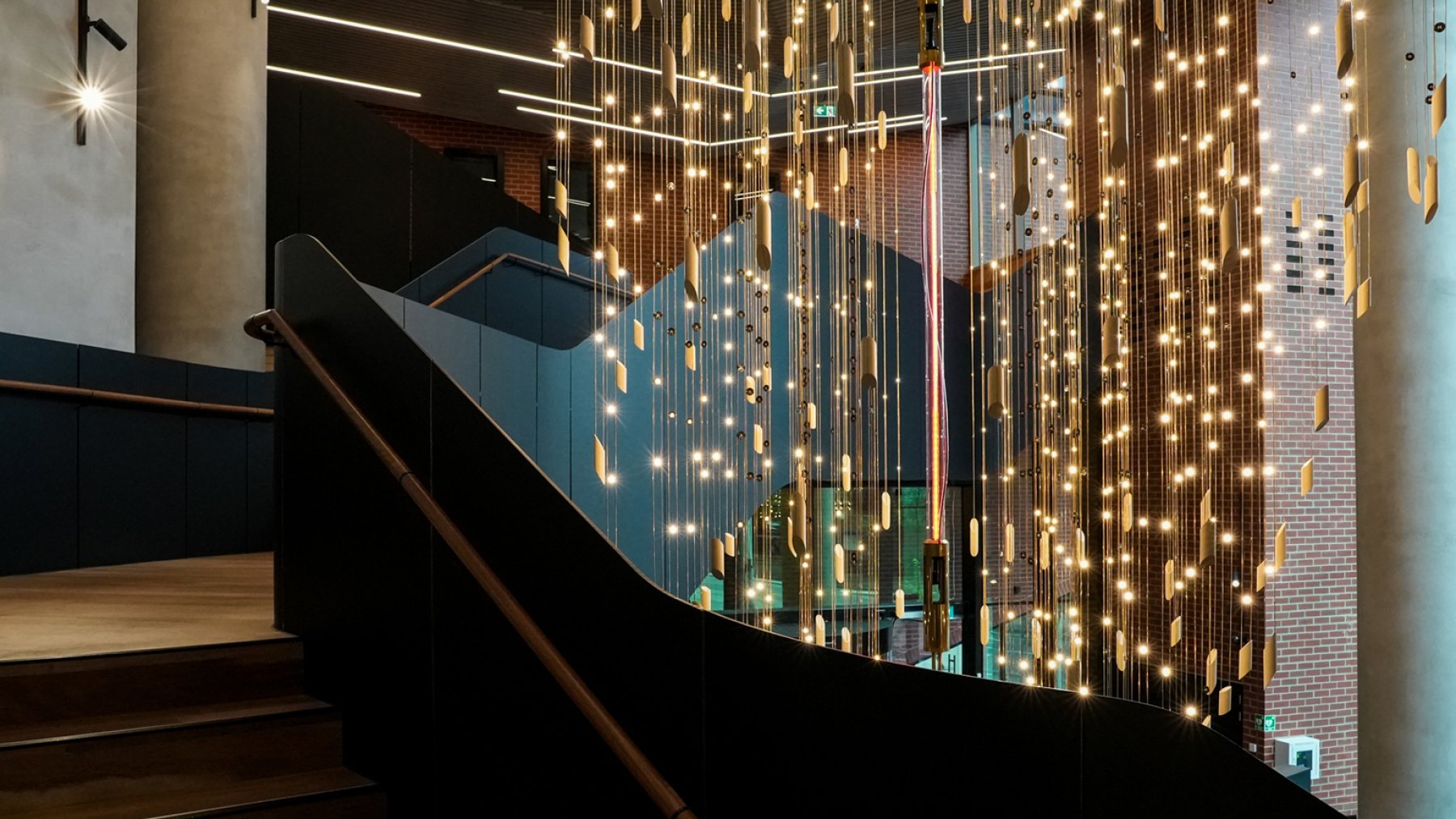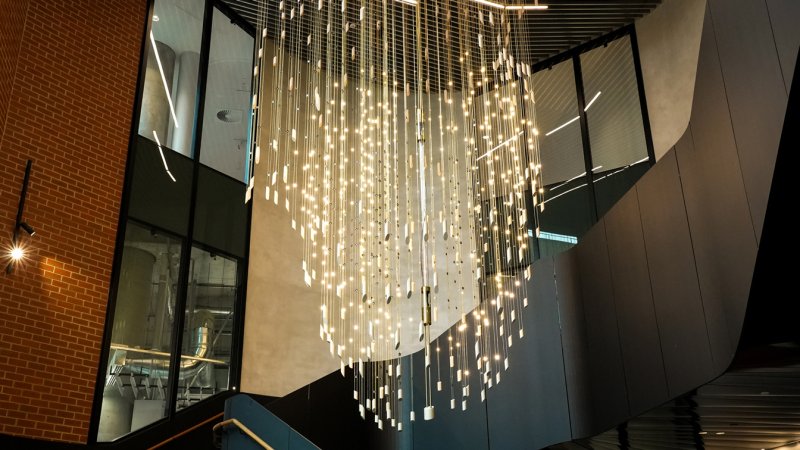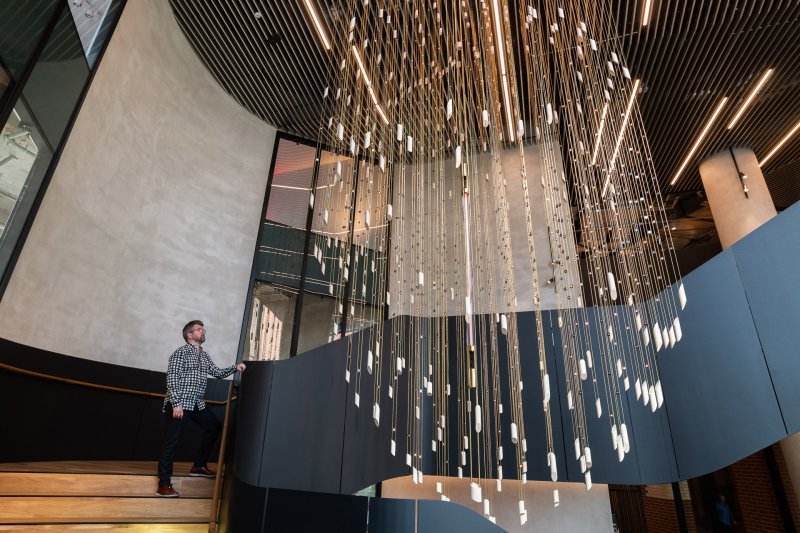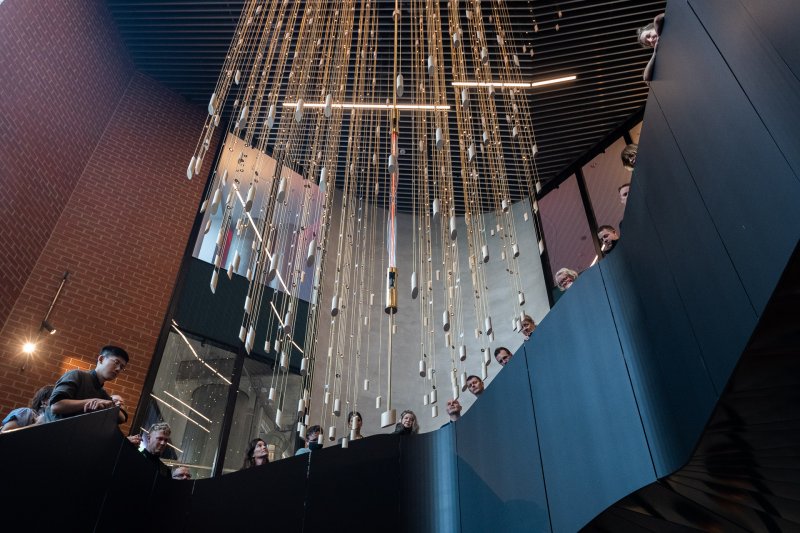The Mirror
EditorialAboutA+a Study CentreA+a ArchiveShopClose Menu

In 2019 the Faculty of Engineering and IT at the University of Melbourne held a competition seeking proposals for a ‘digital feature’ for the foyer of its newest and ‘smartest’ building, Melbourne Connect, planned for the former Royal Women’s Hospital site. With a team of scientists from Human-Computer Interaction, including Zaher Joukhadar, I proposed an artwork to ask, ‘Can a building have a heart?’ Anticipating that the ‘smart’ building and its people would have abundant excellent brains, I wondered if revealing the building’s ‘heart’ might provoke visitors to risk revealing theirs. Our concept won, and we began discovering a form for an artwork called The Heart developed in parallel with the building’s construction.
I worked with university experts to learn how smart buildings surveilled by thousands of sensors feed data to environmental systems that maintain the optimum conditions for people in the most resource-economical way possible. Every sleek room in Melbourne Connect would contain barely perceptible sensors monitoring CO2, humidity, temperature, occupancy and more, while backstage in hidden rooms and floors, an army of machines propel the building’s industry. Disney’s enchanted castles came to mind; their fantastic environments automatically cleaned themselves, relieving humans of labour but diminishing the need to tend, care, or notice the impact of their actions.

I looked at ‘smart building systems’ diagrams and saw a correlation with biological systems in an organism’s body. Would Melbourne Connect be a superorganism? Effectively the plan was to wire the building for sensation and give it the means to respond to stimulus: from clouds moving across solar panels (draw power from elsewhere), to increased CO2 in a crowded meeting room (circulate fresh air), to movement in a quiet corner (activate lights). Would a visitor’s presence, breath, work, and movement make them part of this superorganism? Melbourne Connect’s perpetual sensing would feed data to its ‘digital twin’ and direct the building to react. I wanted to find a way to stage this hidden live work and resurface the traces of actions stored in digital data in a register perceptible to visitors. We had the opportunity to integrate this artwork into the fabric of the building as it was constructed.
Zaher and I began to discuss how we might gather and manipulate the live sensor data and extrapolate a pulse for Melbourne Connect that fluctuated with the building’s activity. We worked with heart anatomy expert Charles Sevigny to understand the physiological factors that impact heart rate and translated the idea of blood pressure to ‘data pressure’.
During this process, we discovered that many of the claims made for smart building sensors and the data they produce were over-inflated and that many systems obfuscate data behind proprietorial firewalls. Accessing the live data streams became a negotiation of several years involving the University’s legal department. Once we gained access, we learned that all the sensors took their readings at different times and frequencies, sometimes fifteen minutes apart. The most obvious challenge was translating the fluctuating state of large numbers of sensors (c 4800) into palpable form without it appearing as random noise—the story of the building’s changing state is interesting, the isolated state of each moment is not. To tell this story of changing states we needed to enable The Heart to become accustomed to its sensations over its ‘lifetime’, and allow it to be surprised.
To achieve this, we used a Manifold Learning machine learning algorithm to enable The Heart to become accustomed to the live ‘sensations’ it receives from its ‘body’ (the building) over the course of each day. This algorithm can translate the 4800 dimensions of the sensor data into lower dimensions, such as 3D, while preserving the relationships between points. We plotted out a daily rhythm for The Heart including waking, working, playing, winding down, and sleeping. At night when The Heart ‘sleeps’, it creates a new manifold merged with the previous days’ manifolds. When awake, it compares what it ‘feels’ in the present against its habituated experience of the past. If current ‘sensations’ fall outside of the manifold it experiences surprise and increases its pulse. This is palpable as a change in the frequency of The Heart’s neon red core, the ephemeral ‘eternal flame’ of the work, and the speed of wave animations emanating through the volume of LEDs suspended on brass droppers.
To address the gap of infrequent sensor readings we used a Generative Adversarial Network (GAN) to develop The Heart’s capacity to anticipate what it is about to ‘feel’ based on its ‘lifetime’ of habituated experiences. This ability will increase slowly as The Heart ages and the GAN is trained over years. In this way, The Heart matures as a longform ambient artwork and experiment that grows with the community over decades. It is a provocation to work with and attune to the non-verbal, sensate environment our lives are bound up within and not separate from. As a live work, The Heart offers the community an opportunity to tend, nurture and guide its growth by adding to the bank of animations over the years, revealing new insights into its experience and responsiveness. I am already thinking about what visualisations we might add for The Heart’s first birthday, and how we can invite other artists and scientists to contribute.
The more I discovered about the machine learning algorithms we were deploying to process the thousands of sensor readings from across the building moment to moment, the more I appreciated that The Heart and its processes would be less about Artificial Intelligence and more precisely what I call Automated Intuition. The Manifold Learning and GAN algorithms produce a residue on a par with habit, similar to how organisms become accustomed to their senses stimulated by their experiences moment to moment, day after day. While the same algorithms are often used to produce so-called ‘artificially intelligent’ results in other applications, I see the automated sifting and sedimentation of live data into persistent shapes and structures formed over long durations more like accruing the circumstances for an immanent intuition. This intuition enables the ability to understand sensations (inputs) instinctively, without the need for conscious reasoning, and is therefore more akin to the secrets of the heart than the head. Indeed, as I considered other, more commonly encountered AI applications manipulating text and images, I began to appreciate them as productive forms of automated intuition, not artificial intelligence.


In April 2023 we launched The Heart at Melbourne Connect. It is free to visit during work hours and visible at all times through the large windows onto Swanston Street.
The Heart beats with a pulse powered by automated intuition (AI) algorithms attuned to the sensations of its ‘body’, the building, Melbourne Connect. Like a human heart, it beats indefinitely. It will grow accustomed to life's ebbs, flows, and surprises, moment to moment, day after day. This artwork speculates on a central point, a heart, for staging the overlooked work of the building in light to visually register what bodies can sense, even if not fully understand. As a durational performance artwork, almost a living superorganism, it invites you to live with it, within it, and get to know it over a lifetime, as it is getting to know us.
Author/s: Robert Walton
The Heart was made with Zaher Joukhadar, Paul Lim, Bosco Shaw, Brad Hammond and the team at Melbourne Connect. The full team is listed on Robert Walton’s website.
To find out more about The Heart online visit: https://robertwalton.net/project/the-heart/
Visit The Heart in person at Melbourne Connect, 700 Swanston Street, Melbourne.
Robert Walton. 2023. “The Heart: Automated Intuition Not Artificial Intelligence.” Art and Australia 58, no.2 https://artandaustralia.com/58_2/p178/automated-intuition
Art + Australia Editor-in-Chief: Su Baker Contact: info@artandaustralia.com Receive news from Art + Australia Art + Australia was established in 1963 by Sam Ure-Smith and in 2015 was donated to the Victorian College of the Arts at the University of Melbourne by then publisher and editor Eleonora Triguboff as a gift of the ARTAND Foundation. Art + Australia acknowledges the generous support of the Dr Harold Schenberg Bequest and the Centre of Visual Art, University of Melbourne. @Copyright 2022 Victorian College of the Arts The views expressed in Art + Australia are those of the contributing authors and not necessarily those of the editors or publisher. Art + Australia respects your privacy. Read our Privacy Statement. Art + Australia acknowledges that we live and work on the unceded lands of the people of the Kulin nations who have been and remain traditional owners of this land for tens of thousands of years, and acknowledge and pay our respects to their Elders past, present, and emerging. Art + Australia ISSN 1837-2422
Publisher: Victorian College of the Arts
University of Melbourne
Editor at Large: Edward Colless
Managing Editor: Jeremy Eaton
Art + Australia Study Centre Editor: Suzie Fraser
Digital Archive Researcher: Chloe Ho
Business adviser: Debra Allanson
Design Editors: Karen Ann Donnachie and Andy Simionato (Design adviser. John Warwicker)
University of Melbourne ALL RIGHTS RESERVED
